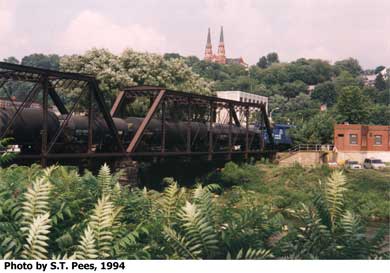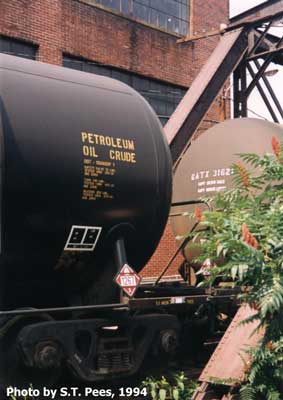 |
||||||
Evolution of the RR Tank Car
Through the years the most noticeable change in tank cars was in size. The 100 barrel tank became the most common size during the 1880’s (The Oil City Derrick and Oil & Gas Journal, 1934). The tanks were about 24-1/2 feet in length and 5 feet six inches in diameter (Redwood, 1913). Then in the 1890’s the tanks were lengthened to 32 feet long and 6 feet diameter which allowed a capacity of 190 barrels (Bolles, 1893). It seems like an increase in size and possibly other modifications happened every decade.
The 32 foot (190 barrel) tank of the 1890’s was built of quarter-inch steel plate. It followed the usual design of having the inlet orifice at the top of the dome and the outlet valve at the bottom to which connecting lines could be attached for emptying. A car could also be unloaded by siphon from the top, but this wasn t the usual practice. In 1892 there were as many as ten thousand tank cars in use in the United States (Bolles, 1893).
By 1916 there were eight different size tank cars for refined oils ranging from 86 barrels to 298 barrels (Bacon and Hamor, 1916) and also greater capacity tanks for crude oil.
Earlier, some tank cars were divided into two or three compartments, each of which held a different refined product. But by the 1940’s that practice was mostly abandoned, the standard tank car carrying only one product at a time. Transverse baffles prevented surging when the car was moving (Shell, 1959). By the 1950’s and probably earlier, the tanks had a top central manhole for filling and for access to allow cleaning and repairs (Shell, 1959).
Some of the large tank cars seen on the tracks today can carry over 600 barrels. They appear to have lost the conspicuous dome although there is a very small one and a device for loading as well as a safety valve. The silhouette of some modern tank cars depart from the strictly barrel-like horizontal cylinder by the ends turning upward somewhat and the middle sagging slightly downward. This shape allows better drainage of the contents and may help to accommodate sloshing when in motion.
The capacity of a tank car is expressed in gallons. The author converted this to barrels by dividing the gallons by 42. The capacity in gallons as well as weight (loaded and empty) in pounds and kilograms are marked by stencil on every tank car.
|
||
|
![]()
| © 2004, Samuel T. Pees all rights reserved |
|

